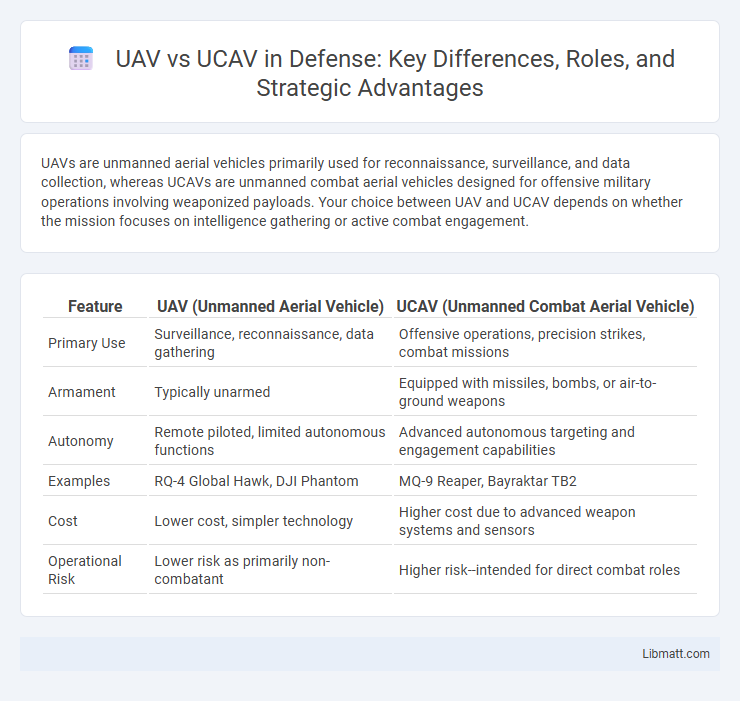UAVs are unmanned aerial vehicles primarily used for reconnaissance, surveillance, and data collection, whereas UCAVs are unmanned combat aerial vehicles designed for offensive military operations involving weaponized payloads. Your choice between UAV and UCAV depends on whether the mission focuses on intelligence gathering or active combat engagement.
Table of Comparison
| Feature | UAV (Unmanned Aerial Vehicle) | UCAV (Unmanned Combat Aerial Vehicle) |
|---|---|---|
| Primary Use | Surveillance, reconnaissance, data gathering | Offensive operations, precision strikes, combat missions |
| Armament | Typically unarmed | Equipped with missiles, bombs, or air-to-ground weapons |
| Autonomy | Remote piloted, limited autonomous functions | Advanced autonomous targeting and engagement capabilities |
| Examples | RQ-4 Global Hawk, DJI Phantom | MQ-9 Reaper, Bayraktar TB2 |
| Cost | Lower cost, simpler technology | Higher cost due to advanced weapon systems and sensors |
| Operational Risk | Lower risk as primarily non-combatant | Higher risk--intended for direct combat roles |
Introduction to UAVs and UCAVs
Unmanned Aerial Vehicles (UAVs) are remotely piloted or autonomous aircraft primarily used for reconnaissance, surveillance, and data collection. Unmanned Combat Aerial Vehicles (UCAVs) are a specialized subset of UAVs designed specifically for combat missions, equipped with precision-guided munitions and advanced targeting systems. The distinction lies in their functionality, with UAVs emphasizing observation and UCAVs focused on offensive military operations.
Defining UAVs: Unmanned Aerial Vehicles
Unmanned Aerial Vehicles (UAVs) are aircraft operated without an onboard human pilot, controlled remotely or autonomously via software-based systems. These vehicles perform a variety of missions, including surveillance, reconnaissance, and scientific data collection, distinguished by their ability to operate in environments unsafe or impractical for manned aircraft. UAVs serve as the foundational technology for more advanced platforms like Unmanned Combat Aerial Vehicles (UCAVs), which integrate weapon systems for combat roles while retaining the UAV's autonomous or remote operational capabilities.
Understanding UCAVs: Unmanned Combat Aerial Vehicles
Unmanned Combat Aerial Vehicles (UCAVs) are specialized UAVs designed for offensive operations, equipped with advanced weaponry and autonomous targeting systems. Unlike standard UAVs that primarily perform reconnaissance and surveillance, UCAVs carry out precision strikes and tactical missions with minimal human intervention. Their integration of stealth technology, real-time data processing, and combat capabilities distinguishes UCAVs as critical assets in modern military aviation.
Key Technological Differences
UAVs (Unmanned Aerial Vehicles) primarily serve reconnaissance, surveillance, and data collection roles, relying on remote piloting or autonomous flight systems without advanced combat capabilities. UCAVs (Unmanned Combat Aerial Vehicles) incorporate sophisticated weapons systems, AI-driven targeting, and robust stealth technologies to conduct offensive operations independently or alongside manned aircraft. Your choice between UAV and UCAV depends on mission requirements, emphasizing either intelligence gathering or active combat engagement through enhanced technological features.
Mission Capabilities: Surveillance vs. Combat
Unmanned Aerial Vehicles (UAVs) primarily excel in surveillance missions, equipped with advanced sensors and cameras for real-time intelligence, reconnaissance, and target acquisition. Unmanned Combat Aerial Vehicles (UCAVs) possess enhanced offensive capabilities, integrating precision-guided munitions and stealth technology for strike operations and battlefield engagement. The distinction in mission capabilities highlights UAVs' role in situational awareness, while UCAVs emphasize direct combat effectiveness and force projection.
Operational Roles and Applications
UAVs primarily serve reconnaissance, surveillance, and data collection roles, enabling real-time intelligence without risking pilot lives. UCAVs, equipped with advanced weaponry, focus on precision strike missions, targeting enemy assets while minimizing collateral damage. Both platforms enhance battlefield situational awareness, but UCAVs extend capabilities to offensive operations and strategic deterrence.
Advantages of UAVs in Modern Warfare
UAVs (Unmanned Aerial Vehicles) offer significant advantages in modern warfare due to their ability to perform reconnaissance, surveillance, and intelligence-gathering missions without risking pilot lives. Their smaller size and lower cost compared to UCAVs (Unmanned Combat Aerial Vehicles) enable more flexible deployment and prolonged operational endurance for persistent battlefield monitoring. UAVs contribute to real-time situational awareness and precision targeting support, enhancing overall mission effectiveness while minimizing collateral damage.
The Tactical Edge of UCAVs
UCAVs (Unmanned Combat Aerial Vehicles) provide a significant tactical edge through their capability to engage targets with precision-guided munitions while maintaining stealth and survivability in contested environments. Unlike UAVs (Unmanned Aerial Vehicles) primarily used for surveillance and reconnaissance, UCAVs deliver direct offensive operations, reducing risk to human pilots and enabling persistent strike missions. Their integration with advanced AI systems enhances real-time decision-making and target acquisition, transforming modern aerial warfare dynamics.
Ethical and Legal Considerations
UAVs (Unmanned Aerial Vehicles) and UCAVs (Unmanned Combat Aerial Vehicles) raise distinct ethical and legal considerations due to their different functions; UAVs primarily serve surveillance and reconnaissance roles with generally lower risk to human life, whereas UCAVs are designed for lethal strikes, intensifying debates on autonomous weapon use, accountability, and international law compliance. The deployment of UCAVs challenges established legal frameworks regarding target identification, proportionality, and civilian protection under the Law of Armed Conflict. Your understanding of these issues is crucial when evaluating the implications of using autonomous aerial technology in military operations.
Future Trends in UAV and UCAV Development
Future trends in UAV and UCAV development highlight the integration of advanced AI technologies, enabling autonomous decision-making and improved mission adaptability. Enhanced stealth capabilities, longer endurance, and increased payload capacities are driving the evolution of both platforms, with UCAVs focusing more on combat effectiveness and UAVs on versatile reconnaissance. Your operational efficiency will benefit from these advancements as they redefine aerial warfare and intelligence gathering.
UAV vs UCAV Infographic

 libmatt.com
libmatt.com